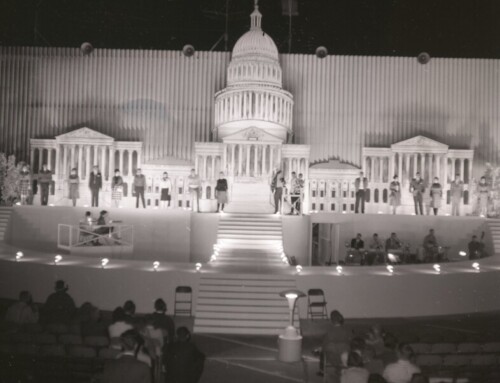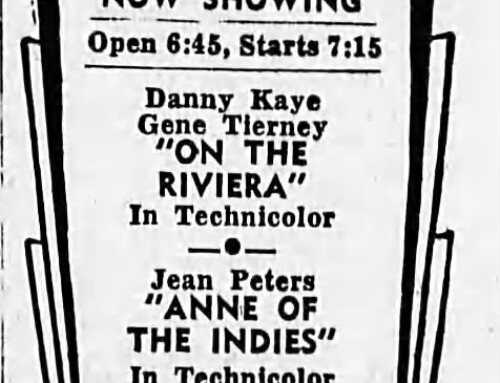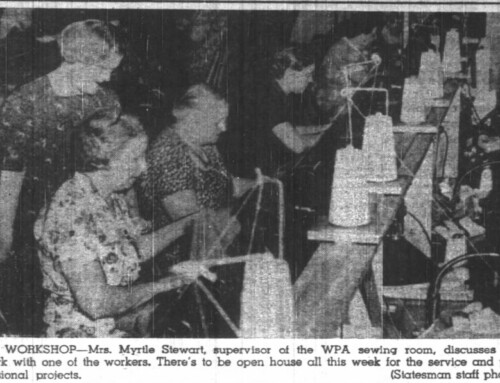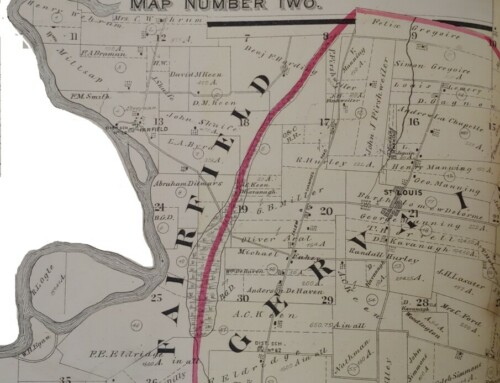
Unloading wool destined to be manufactured into overcoats or blankets for men in the armed services, at the Thomas Kay Woolen Mill in Salem. The woolgrowers as well as the woolen mill workers are doing their part toward victory. Image from Oregon Statesman newspaper, 6 Jun 1943, p. 11.
This article was printed in the Oregon Statesman newspaper on 6 June 1943. It is transcribed here in its entirety to give perspective on the mill’s processes and employees during the army contracts of World War II.
Wool Spells ‘Warmth’ for Soldiers
by Tom Weiss
Rolling out khaki cylinders of overcoat material and bales of blankets to win the war by production at home is nothing new to the Thomas Kay Woolen mill, the grandfather of all coast mills whose products have warmed half a million soldiers in two world wars.
Full crews at the Kay mill are not winning the war by mere piece work on a great clothiers’ assembly line, but are directly buying grease
wool from the farmers of the Willamette valley and processing it. The Kay mill is a unit which takes dirty grey wool from the backs of the sheep and puts clean olive drab blankets on the beds of our fighting men.
Men fighting in Attu and Flying Fortresses miles above the earth in sub-zero temperatures never heard the roar of the shuttles at the Kay mill, but they know too that “wool fights on the front.”
Wool Sacks
Dirty grease wool comes to the Kay mill in 280-pound sacks which yield 140 pounds of clean wool to make 30 army blankets. That means that ten American soldiers are warmed with blankets not seized from the shivering people of any occupied country. That means the American way of equipping our soldiers is working and sacrificing, not pillaging.
Scouring
After the wool leaves the sorting sheds, it is opened and dusted to be sent to the huge scouring bowls where steel tongs stir and drive the wool in boiling alkali water. C.T. Okerberg has been loading wool into the bowls for 18 years, but he says he has never loaded so much so fast. Evidently our fighting men are getting enough soon enough.
Dyeing
The wool is then dyed four olive shades in vats and combined with 15 per cent white wool to produce the exact shade of olive drab which blends with the foliage and earthen color in protecting American and other Allied soldiers while they sleep camouflaged within sight of the enemy. Troops are shielded by the dyers at the Kay mill. That’s saving an American life. That’s winning the war on the fighting front by work in Salem.
Burr-picked and Nap-tucked
Because blankets are both sheets and comforters to the army, they must be burr-picked to remove irritating fibers and nap-tucked to give the blanket a tight wind resisting quality. Blankets must be preshrunk and durable too, for our soldiers stretch them out on damp marshes and rocky terrain in their fighting treks after fleeing enemy armies.
Air Shoots
At present the wool is shot through pipes by air pressure from the burr pickers to the carding machines which make strands of wool rope. The air shoots are something new at the mill and replace three men who used to truck the wool from station to station. This new equipment has speeded production, released mill hands for the service and other war work and improved the general efficiency of the plant.
Spinning Mules
After the wool rope leaves the carding machines it is spun in the huge spinning mules 36 feet wide that stretch and spin 250 strands of wool rope into yarn at a time. Incidentally, one worker from the spinning mules joined the U.S. cavalry, was commissioned a second lieutenant, kicked by an army mule, and now has received his medical discharge to return to the Kay mules. Wilbur F. Berry, superintendent of the mill, said that Kay mules – in spite of their size have never kicked anyone.
Looms
When the wool goes to the looms it is woven into blankets. Weavers watch the pounding shuttles race crossways between strands of yarn and keep on the alert for broken fibers. Only now can one realize the direct help of the Willamette valley farmer to our fighting men. His 14 fleece have been through the mill. More than 14 soldiers will benefit from their work.
Cutters
Yards of blanket material are later passed to cutters who are able to slice stacks of blankets within a tenth of an inch of army specifications. One of these blanket cutters has worked at the Kay mill 18 years and her partner has worked only eight months; yet the energy of the younger and the experience of the older worker have combined to produce efficiently.
Stamped
Before the blankets are crated for shipment to quartermasters’ depots on the east and west coasts, they are stamped with a huge US and marked with the Kay mill’s contract number, the type of blanket – 100 per cent wool – the specifications – the purchaser, Uncle Sam – and the name of the government inspector who checks each blanket for shrinkage and workmanship.
New Machines
Shortly before the war the carding machines at the mill formed such a bottle neck in the assembly line that the Kay company was able to work only two shifts. Now with the newer machines, all water and supplementary electric power can be used for three shifts with a result that production at the mill has almost been doubled.
Doubled Production
Doubled production in a small mill may seem like a slight thing. Perhaps it is, when one thinks of world production figures, but when one considers the thousands of men clothed by the single unit of the Kay mill in Salem, many times the number of men at Camp Adair, a blanket for every soldier every time he comes to Salem, the production figures no longer seem small.
When Salem soldiers return from the war, many of them may tell how they slept in a Kay blanket from their hometown, and they will not only be glad that they are back, but that they kept warm while they were gone because there were people at home winning the war through production in Salem.






